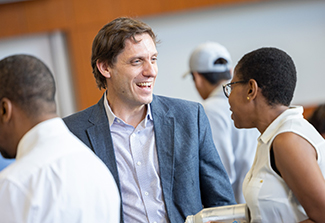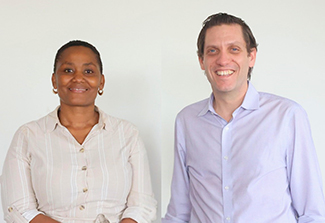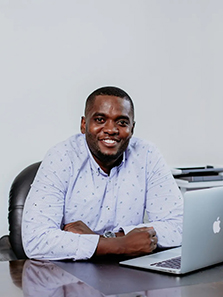Nutritional research in Tanzania may help coal miners in the U.S.
July/August 2025 | Volume 24 Number 4
 Photo courtesy of Scott HeysellDr. Scott Heysell at a Tanzanian research symposium
Photo courtesy of Scott HeysellDr. Scott Heysell at a Tanzanian research symposium
Chronic respiratory disease, including asthma, is a common diagnosis in the United States—in fact, it’s the fifth most common cause of death. By contrast, tuberculosis (TB) is an unusual diagnosis in the U.S.
Yet TB research conducted in Tanzania will likely prove beneficial for Americans, say Dr. Scott Heysell, a professor of international medicine at University of Virginia (UVA), and Dr. Stellah Mpagama, a physician-scientist at Kibong’oto Infectious Diseases Institute in Tanzania. They are co-principal investigators of a Fogarty Global Infectious Diseases Research Training Program project.
“In the U.S. and where I work in Appalachia, there's a lot of coal mining,” explains Heysell. In Tanzania, there's a roughly equal rate of mining (though for different commodities), and so people develop lung disease from silicosis or other environmental aspects of the industry just as they do in the U.S.
This shared history of similar environmental exposures and chronic lung disability suggests Tanzanian research will likely translate to the American context. Studying how a targeted nutritional intervention, given either before or during a TB episode, impacts chronic lung disease “will possibly have direct implications for any nation where chronic lung disease is common,” says Heysell.
Learn by doing
Ancient in origin, tuberculosis is a serious infectious illness affecting the lungs. It’s caused by bacteria that spread via droplets propelled into the air when an ill person coughs or sneezes.
Some people who inhale TB germs have strong immune systems, so their bodies successfully fight off disease. Others have weaker systems and so disease develops, leading to weight loss and possibly wasting.
“Malnutrition is a consequence yet also a cause of tuberculosis—it is the leading risk factor for developing tuberculosis,” says Heysell. People who are undernourished lack a healthy immune response, so, following exposure to germs, they’re likely to progress to disease, which leads to a worsening of their famished condition.
This bidirectional relationship between sustenance and disease is where Heysell and Mpagama center their TB project.
Mpagama says, “Our research explores all forms of nutritional status in TB patients to understand how nutrition influences disease outcomes.” Undernutrition and poor nutrition are closely related but distinct, she explains. Undernutrition is defined as inadequate food intake that leads to deficiencies in essential nutrients and then presents as wasting, stunting, or being underweight. “Malnutrition is a broader term that includes both undernutrition and overnutrition—where excessive or imbalanced intake (such as too much sugar, salt, or fat), often without meeting essential nutrient needs, leads to overweight and obesity.” Overnutrition can lead to diabetes, where high levels of blood sugar affect immune cell function, impairing the body’s ability to defeat infections.
 Photo courtesy of Scott HeysellDr. Stellah Mpagama and Dr. Scott Heysell
Photo courtesy of Scott HeysellDr. Stellah Mpagama and Dr. Scott Heysell
Heysell’s and Mpagama’s project will train six post-doctoral candidates to become independent researchers at leading institutions across the country including the Kilimanjaro Christian Medical University College and Kilimanjaro Clinical Research Institute (KCMUCo/KCRI), Kibong’oto Infectious Diseases Hospital, Muhimbili University of Health and Allied Sciences, and the University of Dodoma. Pursuing separate research plans, each will investigate how the gut microbiome, nutritional interventions, pulmonary rehabilitation, chronic lung disease, and the bacterial infection of TB interact and intertwine.
“Our role is to provide guidance, mentorship, and encouragement to help them build confidence and pursue their professional goals,” says Mpagama.
Why Tanzania?
Mpagama’s and Heysell’s training grant began in March 2022 and ends in February 2027, by which time each trainee should be capable of competing for NIH and other global funding, setting research agendas, and overall contributing to policymaking and to the community. “Two of the six total postdocs in the earliest cohort are just finishing their projects and the latest cohort just started,” says Heysell.
Metrics of success include academic promotion, development of a research team, and grant submission and receipt. Heysell says, “So we've had a fair amount of success; those who started at the beginning have been academically promoted and their research teams have grown. They’ve also published scientific papers and submitted research grant proposals to the National Institutes of Health and other funders— they haven't received word back, so it’s too early to determine the success of those grants.”
Training in Tanzania, one of the World Health Organization’s high burden TB countries, is crucial because TB needs to be studied in endemic areas (where it's most common). “While tuberculosis exists in the United States—for instance, a little over 10,000 people were diagnosed with the disease in 2024—we need a much greater scale of impact and severity of disease presentation to really understand scientifically how to intervene,” says Heysell.
Tanzania is also a country with high rates of undernutrition. “We need to understand how undernutrition leads to TB disease, and then how we might target and treat undernutrition either before tuberculosis develops or during the disease course itself,” Heysell explains.
Building the research workforce in Tanzania is an equally important goal. “Importantly, the approaches, findings, and frameworks we develop are designed to be transferable and applicable to other diseases, including pandemics and other health threats on and outside the continent,” Mpagama says.
Conducting research in Tanzania provides opportunities not found in the U.S., but there are snags as well, says Heysell. “Getting the timeline right is one challenge. For instance, we think we'll be able to do this in two months when in fact it takes six because of the regulatory environment or getting something shipped and having it arrive on time with the proper paperwork.”
UVA’s 20-years-plus history in the Kilimanjaro region helps smooth many difficulties, says Heysell. “The long-term relationship that UVA has established with partners in the region facilitates a lot of the work that would be more difficult if we were starting from scratch.”
Heysell adds that the project’s collaboration structure is fairly unique. “We not only have the D43 training grant in malnutrition and tuberculosis, but we also have a Fogarty-supported G11 grant to fund research administration training. So as our postdoctoral students in Tanzania are developing their research careers, they're paired with research administrators who are being trained in pre-award and post-award compliance,” adds Heysell.
Evolving priorities
Mpagama’s TB research aims to prevent premature deaths and curb transmission, especially of difficult-to-treat multidrug-resistant strains. “I’m equally focused on minimizing the long-term health impacts many patients face.” A significant number of TB survivors develop chronic lung disease due to lung scarring, leading to reduced quality of life, lower productivity, and increased risk of early death. Notably, she’s also led the development of a clinical trial platform to accelerate patient access to effective interventions while contributing to socio-economic development. “Establishing a well-resourced clinical trial unit with highly trained staff ensures reliable evidence and patient safety, while advancing science and innovation tailored to local contexts,” she says.
Heysell’s previous TB-related ventures include research of diagnostics, implementation, and prevention. “Some of that work is in response to the evolving TB pandemic.” When he first started in the TB field, adequate diagnostics for drug-resistant disease did not yet exist, and it was his global partners who understood that effective tests would be needed to improve patient outcomes. “Once NIH-funded and industry-supported development of drugs and diagnostics improved, we then began to look at implementation of those diagnostics and therapeutics,” explains Heysell. Over time, his research evolved to focus on upstream drivers of TB as well as how to prevent post-tuberculosis downstream consequences.
“I’ve often collaborated on what my partners believe is the highest priority to weaken tuberculosis’ impact on their communities at any given time,” says Heysell.
Mpagama says the current U.S. administration is addressing poor nutrition as a national health concern, “so the methodologies and key insights generated from our work may be applicable—either directly or indirectly—in that context.”
She adds, “There is also an opportunity to expand this research to the U.S. to address its own malnutrition challenges. This would produce valuable cross-country comparisons that help reveal common, underlying mechanisms and inform more effective strategies for addressing malnutrition in both local and global settings.”
Heysell concludes, “We need to change a lot of how we approach nutrition here in the U.S. Through the work we’re doing in Tanzania, we'll be able to understand how a nutritional intervention affects the immune system in a really important way.”
 Photo courtesy of Kennedy NgowiKennedy Ngowi, PhD
Photo courtesy of Kennedy NgowiKennedy Ngowi, PhD
One trainee's project
Kennedy Ngowi, PhD
Project:
Developing and implementing a knowledge hub for malnutrition and tuberculosis using artificial intelligence and data science
Buried deep within accelerating data streams generated by innumerable health care systems across the globe are much-needed insights that can improve health.
In Tanzania, Kennedy Ngowi, PhD, hopes to use advanced machine learning algorithms and data science approaches to extract such life-saving perceptions to improve patient outcomes by identifying individuals at higher risk of treatment failure. For his project, he’s building a knowledge hub to inform the treatment of patients with tuberculosis (TB) and malnutrition.
“A knowledge hub goes beyond the traditional way of collecting and using data. It is a smart digital repository,” explains Ngowi. In this case, the hub ingests general clinical data, research data, epidemiological data, demographic data, regional economic data, climate data—a range of diverse information—and permits the use of analytical technologies to spot and interpret potential trends in treatment outcomes. Importantly, this knowledge hub does not rely on patient data from a single hospital but taps various sources instead.
Development of a knowledge hub is particularly important when dealing with intertwined conditions like TB and malnutrition. When conditions interact, it’s difficult to detect the reasons why disease is prolonged for some patients or why other patients experience unexpectedly poor results, says Ngowi. The hub helps stakeholders see and find these answers across diverse datastreams.
Indicators & dashboards
Ngowi, working within a multidisciplinary collaboration from UVA data Science department, has already begun applied various predictive modeling techniques to determine preliminary analysis of a large dataset using gathered at Kibong’oto Hospital, which serves as Tanzania’s infectious disease institute and cares for patients with multi-drug-resistant TB. The key objective was to determine whether patient characteristics and clinical indicators could effectively predict treatment outcomes.
“What we've seen across all models and dataset is that a patient's body mass index (BMI) and other nutrition-related factors consistently stood out as key predictors. These findings underscore the vital role that proper nutrition plays in TB recovery. Those who are underweight are less likely to experience good results following treatment,” says Ngowi. Based on this finding, patients’ BMI is now measured immediately so that clinicians can begin providing nutrients for those who are underweight. “We want to understand where the standard of care will do and where we need to provide specialized services. This way, we can preserve our resources and serve more patients.”
While gaining a deeper comprehension of the range of prognoses for patients, Ngowi also aims to provide distinct dashboards suited to different web platforms to improve accessibility. “We need to make sure that the knowledge hub is available to key stakeholders, including care providers who use tablets in the clinic, so they can improve all their decisions,” says Ngowi.
Local context
While working on his master's degree in software development and innovation at Aalborg University in Denmark, Ngowi became interested in the idea of using technology to solve real-world problems. “In Tanzania at this time, access to mobile phones was booming and infrastructure was also improving.” He knew this newly established mobile platform could be used to develop technological solutions for his home country.
Returning to Tanzania, he began working with databases of clinical, epidemiological, and patient information. “What we came to realize is that all the hospitals had a different way of collecting information, so the data were disintegrated. When we most wanted to use data to improve our decisions, we could not.”
Meanwhile, he observed an unexpected challenge in health institutions where he worked. “I'm seeing patients unable to adhere to their treatment plans—they forget to come to the clinic, or they don’t remember to take their medications.” Able to recall when Tanzania suffered from drug stockouts, he immediately understood that this new, very different problem would hurt progress in a similar way.
So Ngowi led a collaboration to build an mHealth intervention that relied on real-time medical data to improve both clinic retention and treatment adherence. Although patients liked the intervention, his team could not gather evidence to prove its feasibility. “Another problem was that some patients had issues outside the scope of treatment, but that information also was not available, probably due to our data extracting and collecting methods.”
The intervention didn't significantly improve overall treatment outcomes. However, it helped more people reach relatively good levels of medication and was found to be highly acceptable, feasible, and beneficial, enhancing patient-provider communication and healthcare access in remote areas.
Ngowi still learned an important lesson. “We knew we could not rely on real-time medical data only to monitor and address cases.” He also recognized the need to merge research and public health databases to look for “outside variables” not found in hospital records.
“Now, my main focus is making sure this hub is continuously implemented and works well within our settings,” says Ngowi. Day-in and day-out, he and his team collect and refine data. “People need to understand the importance of making sure data are standardized so that advanced technology analysis can be done.” He’s recently welcomed three University of Virginia data science students onto his team to begin this process of knowledge transfer.
For Ngowi, the most important lesson is the simplest: Inadequate data leads to false predictions and false predictions do not help patients. “We want to predict the truth, so we need good, quality data.”
More information
Updated August 22, 2025
To view Adobe PDF files,
download current, free accessible plug-ins from Adobe's website.
Related Fogarty Programs
Related World Regions / Countries
Related Global Health Research Topics